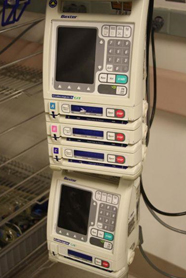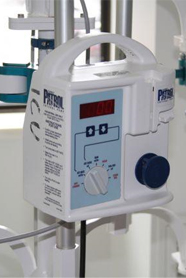toh
Ventilators
A Ventilator or “Breathing Machine” is a machine that does some or all of the work of breathing for a patient. Ventilators are used to support breathing or aid the function of the lungs. The machine forces air into the lungs through a tube inserted into the windpipe (trachea) or using a tightly fitting mask. This breathing support may be used to help get enough oxygen to the body and to remove carbon dioxide. Sometimes ICU patients need support from a ventilator because they are not awake enough or strong enough to breath safely on their own.

Monitors
Critically ill patients in the ICU require close monitoring. One way in which many patients in the ICU are monitored is by displaying their “Vital Signs” (heart rate and rhythm, blood pressure, and respiratory rate) on a digital monitor. The ICU care team can see these monitors at the patient’s bedside and at the main unit desk, and can react quickly to changes when they occur.

Dialysis
A dialysis machine, or “artificial kidney” is a treatment used to take over the work of the kidneys and remove fluid, waste products, and some poisons from the blood. In order to remove the blood for dialysis a special type of IV is put into a large vein in the neck or groin. Blood flows out of the IV and through the dialysis machine where it is filtered and then returned to the body. Dialysis can take over the some of the function of the kidneys but it generally does not help the kidneys to heal if they have been injured. Some patients outside the hospital live on dialysis for years, but the type of dialysis done for ICU patients is typically used for short periods of time.
IV Pumps
Many of the medications and treatments given in the ICU must be administered directly into the blood stream by use of an intravenous catheter (IV). Continuous flow (infusions) or extra doses (boluses) of these medications can be given by the ICU doctors and nurses using a programmable IV pump. You will often see the nursing staff connecting medications to the IV pumps, programming the doses and attending to them when an alarm sounds.

Feeding Tubes
Feeding tubes are a way of giving nutrition and fluids when critically ill patients are not able to eat. Usually, the tube is inserted into the stomach through the nose (nasogastric or NG tube). Sometimes feeding tubes are placed directly into the stomach through the skin (gastronomy tube or PEG). The ICU dieticians help to choose the liquid food mixture that will provide to best nutrition to each critically ill patient. This liquid food mixture is pumped through the feeding tube into the patients stomach using a programmable pump.

Last updated on: November 17th, 2016


 To reset, hold the Ctrl key, then press 0.
To reset, hold the Ctrl key, then press 0.